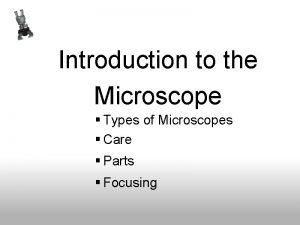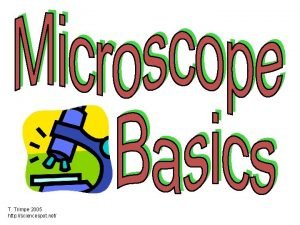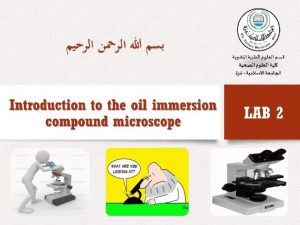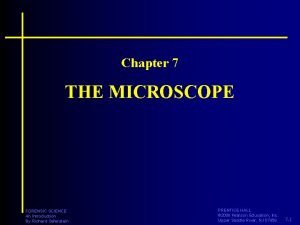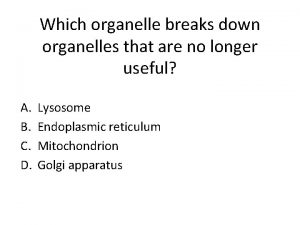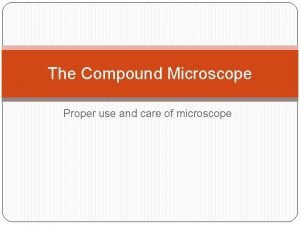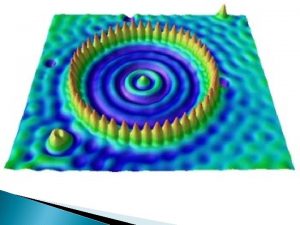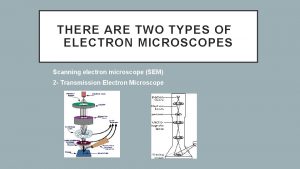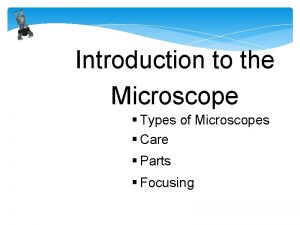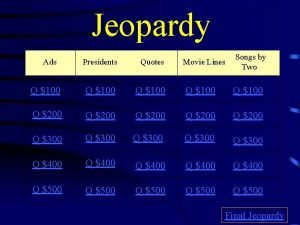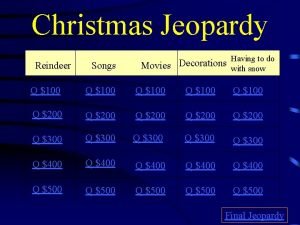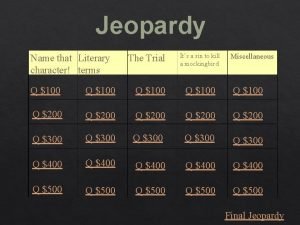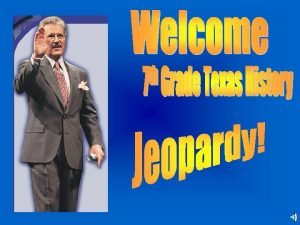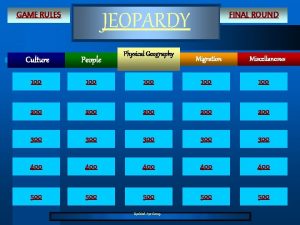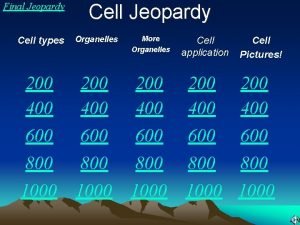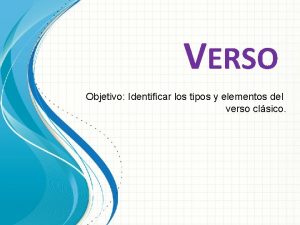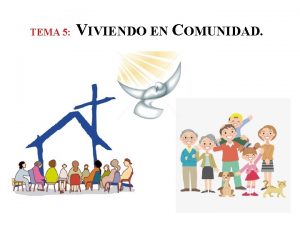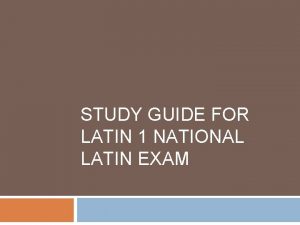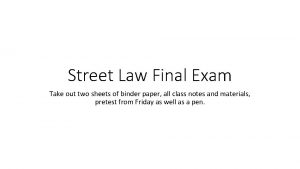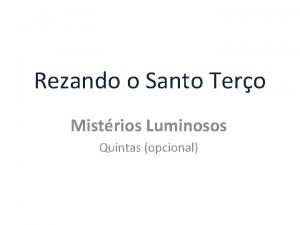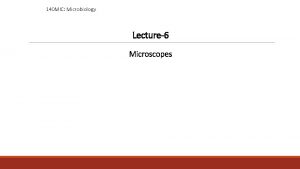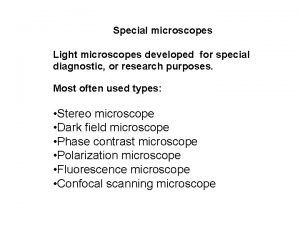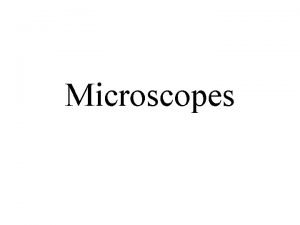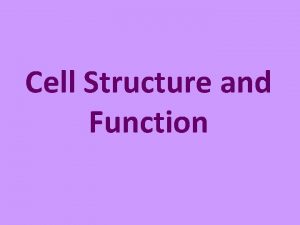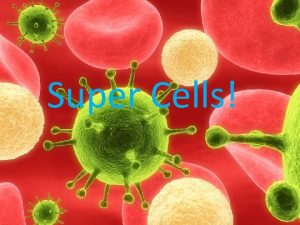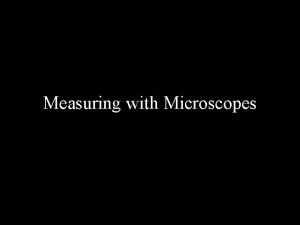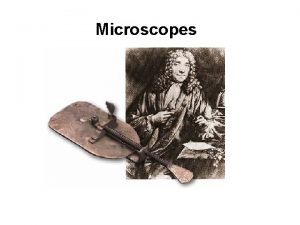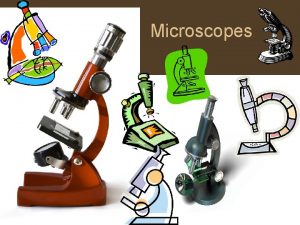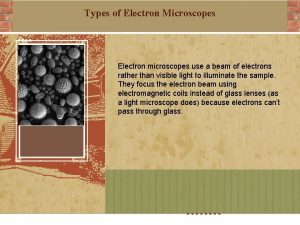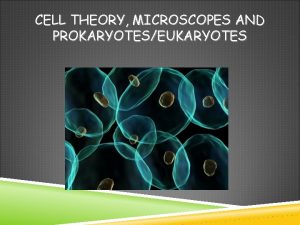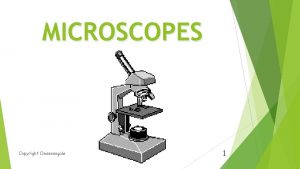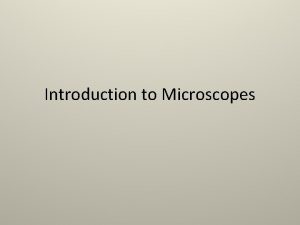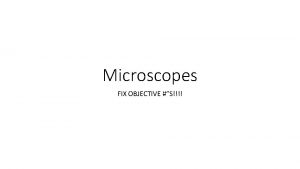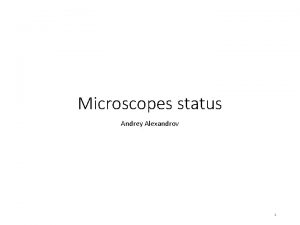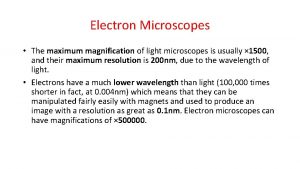Jeopardy Final Jeopardy MICROSCOPES PART 1 MICROSCOPES PART











































































- Slides: 75

Jeopardy Final Jeopardy MICROSCOPES PART 1 MICROSCOPES PART 2 MICROSCOPE DIAGRAM CELLS PART 1 CELLS PART 2 CELL DIAGRAM 100 100 100 200 200 200 300 300 300 400 400 400 500 500 500

What is the difference between a SIMPLE and a COMPOUND Microscope ? A 100

A Compound Microscope has more than one lens A 100

What did Robert Hooke discover ? A 200

He discovered CELLS A 200

What was Anton van Leeuwenhoek’s contribution to Science ? A 300

He discovered tiny MICROORGANISMS A 300

What happens to a microscope’s FIELD OF VIEW when magnification INCREASES ? A 400

It DECREASES A 400

What would the TOTAL MAGNIFICATION of your microscope be if you are using an Objective Lens with a magnification of 45 X ? A 500

It would be 450 X A 500

The magnifications of the OBJECTIVE LENSES of our microscopes are… B 100

4 X, 10 X, 40 X B 100

The microscopes we use in class are called…. B 200

COMPOUND LIGHT MICROSCOPES B 200

The microscope part used to adjust the amount of light on the slide is called ? B 300

The DIAPHRAGM B 300

What is the “platform” upon which the slides or specimens are placed for viewing? B 400

The STAGE B 400

Which part of the microscope should NEVER be used when viewing a slide under “HIGH” power? B 500

The COARSE ADJUSTMENT KNOB B 500

The Part labeled “ 1” is the… C 100


EYEPIECE C 100

PART 5 is the C 200


COARSE ADJUSTMENT KNOB C 200

The function of PART 4 is C 300


To adjust the amount of light on the slide C 300

What is PART 2 ? C 400


The OBJECTIVE LENS C 400

What is the function of PART 3 ? C 500


To hold the slide or specimen in place. C 500

The tiny structures that carry out different functions within the cell are D 100

ORGANELLES D 100

List the 3 statements of the Cell Theory. D 200

1. All living things are made of cells 2. Cells are the basic units of structure and function in living things. 3. Cells are produced from other cells D 200

a. Organisms whose cells have Nuclei are…. . b. Organisms having cells that DO NOT have Nuclei are…. . D 300

a. EUKARYOTES b. PROKARYOTES D 300

All of a cell’s functions are controlled by which structure ? D 400

The Nucleus D 400

List the correct order of the LEVELS OF CELLULAR ORGANIZATION: D 500

1. Cells 2. Tissues 3. Organs 4. Organ Systems 5. Organism D 500

Protein production is carried out by which organelles? E 100

RIBOSOMES E 100

The function of the cell’s VACUOLES is: E 200

STORAGE of materials E 200

The structure that controls which substances enter or exit the cell is the E 300

CELL MEMBRANE E 300

Organelles that break down sugars in order to produce energy are E 400

MITOCHONDRIA E 400

The organelles in which PHOTOSYNTHESIS occurs are E 500

CHLOROPLASTS E 500

Energy production occurs in which of the organelles? F 100


PART 9 F 100

Part 8 are F 200


RIBOSOMES F 200

Photosynthesis occurs in which organelle ? F 300


PART 3 F 300

Which structures are found only in PLANT cells and not in ANIMAL cells ? F 400


Parts 2 & 3 F 400

Identify Parts 4, 6, & 7 F 500


Part 4: CHROMATIN PART 6: E. R. PART 7: VACUOLE F 500

Today’s Final Jeopardy category is Please make your wager

FJ Question

FJ Answer

Gracias por jugar Jeopardy
 Types of microscopes
Types of microscopes Sciencespot net
Sciencespot net Microscope purpose
Microscope purpose Forensic science microscopes
Forensic science microscopes Which of the following enclose their dna in a nucleus
Which of the following enclose their dna in a nucleus Body tube microscope
Body tube microscope Electron microscopes main idea
Electron microscopes main idea Types of electron microscopes
Types of electron microscopes Types of microscopes
Types of microscopes When focusing a specimen you should always start with the
When focusing a specimen you should always start with the World geography final jeopardy
World geography final jeopardy College jeopardy questions
College jeopardy questions Todays final jeopardy question
Todays final jeopardy question Jeopardy preparation books
Jeopardy preparation books Jeopardy movie quotes
Jeopardy movie quotes Jeopardy final question today
Jeopardy final question today Christmas jeopardy background
Christmas jeopardy background Final jeopardy wager calculator
Final jeopardy wager calculator Jeopardy final question music
Jeopardy final question music Literary characters final jeopardy
Literary characters final jeopardy Todays final jeopardy answer
Todays final jeopardy answer Colonial america jeopardy
Colonial america jeopardy Final jeopardy queue
Final jeopardy queue Beatles jeopardy questions
Beatles jeopardy questions Random final jeopardy questions
Random final jeopardy questions Todays final jeopardy answer
Todays final jeopardy answer Todays final jeopardy
Todays final jeopardy Comparing numbers jeopardy
Comparing numbers jeopardy Ancient greece jeopardy
Ancient greece jeopardy Geographic regions final jeopardy
Geographic regions final jeopardy Cell organelle jeopardy
Cell organelle jeopardy True or false to kill a mockingbird
True or false to kill a mockingbird Synonym for double jeopardy
Synonym for double jeopardy Parts of speech jeopardy
Parts of speech jeopardy Jeopardy part 1
Jeopardy part 1 Addition symbol
Addition symbol Part to part ratio definition
Part to part ratio definition Part part whole
Part part whole Technical description
Technical description Explain parts of bar
Explain parts of bar The phase of the moon you see depends on ______.
The phase of the moon you see depends on ______. Part to part variation
Part to part variation Consumable stores on hand in balance sheet
Consumable stores on hand in balance sheet World history spring final exam review answers
World history spring final exam review answers World geography spring final review
World geography spring final review Fyp final year project
Fyp final year project Eku merit scholarships
Eku merit scholarships Indot final tracings checklist
Indot final tracings checklist Web design final exam
Web design final exam Licencias poeticas
Licencias poeticas Utnfrcu
Utnfrcu Ejemplos de sinalefa
Ejemplos de sinalefa Us history final exam semester 1
Us history final exam semester 1 Income method gdp formula
Income method gdp formula Vertical format of trading profit and loss account
Vertical format of trading profit and loss account The final decrees of the council of trent
The final decrees of the council of trent Sbu final exam schedule
Sbu final exam schedule Oración final de comunidad
Oración final de comunidad Final del tubo
Final del tubo National latin exam results
National latin exam results Latin 2 final exam
Latin 2 final exam Street law final exam
Street law final exam What is syllable
What is syllable Spanish 2 final exam 100 questions
Spanish 2 final exam 100 questions Spanish 1 answers
Spanish 1 answers Sempre é preciso saber quando uma etapa chega ao final
Sempre é preciso saber quando uma etapa chega ao final English 11 a semester exam
English 11 a semester exam Biology second semester final exam answers
Biology second semester final exam answers Soluciones
Soluciones Freak the mighty final project
Freak the mighty final project Which two characters are detained by the watchmen
Which two characters are detained by the watchmen Reza gloria ao pai
Reza gloria ao pai Pltw human body systems final exam
Pltw human body systems final exam Ley del acento final
Ley del acento final Intensifying stage of a relationship
Intensifying stage of a relationship Final thought example
Final thought example
